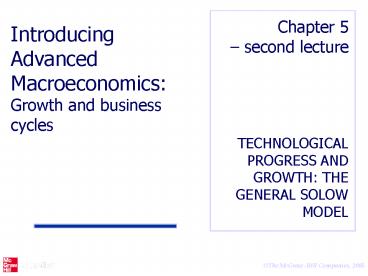TECHNOLOGICAL PROGRESS AND GROWTH: THE GENERAL SOLOW MODEL - PowerPoint PPT Presentation
1 / 24
Title:
TECHNOLOGICAL PROGRESS AND GROWTH: THE GENERAL SOLOW MODEL
Description:
Chapter 5 second lecture Introducing Advanced Macroeconomics: Growth and business cycles TECHNOLOGICAL PROGRESS AND GROWTH: THE GENERAL SOLOW MODEL – PowerPoint PPT presentation
Number of Views:250
Avg rating:3.0/5.0
Title: TECHNOLOGICAL PROGRESS AND GROWTH: THE GENERAL SOLOW MODEL
1
Chapter 5 second lecture
Introducing Advanced Macroeconomics Growth and
business cycles
TECHNOLOGICAL PROGRESS AND GROWTH THE GENERAL
SOLOW MODEL
2
The complete Solow model
3
Analyzing the Solow model (see previous lecture)
- Define and
- From we get
- From and we get
- Dividing by on
both sides gives
4
- Inserting gives the transition
equation - Subtracting from both sides gives the Solow
equation - Dividing by on both sides to get the modified
Solow equation
5
Previous lecture
- Using the transition equation and the transition
diagram we showed convergence to steady state
. - We derived some relevant steady state growth
paths e.g. - We showed that there is balanced growth in steady
state with and growing at the same
positive growth rate, , and with a constant
real interest rate, . - We discussed structural policy aimed at affecting
steady state. - We showed and discussed empirics for steady
state The model substantially underestimates
the impact of the structural parameters on GDP
per worker!
6
This lecture
- Comparative analysis in the Solow diagrams.
- The convergence process.
- Growth accounting.
7
The Solow diagram
8
The modified Solow diagram
9
Comparative analysis in the Solow diagrams
- Initially the economy is in steady state at
parameters and . The savings rate
increases permanently from to .
10
(No Transcript)
11
- Old steady state and
, and and both grow at rate ,
the lower line below - New steady state and
, and and grow at rate , but along a
higher growth path, the upper line above.
12
- Transition grows from up to
. The growth rate of jumps up and then
gradually falls back to zero. From
follows that . Hence, during the
transition, grows at a larger rate than ,
and jumps up and then falls gradually back to
. The growth rate of jumps too, since
.
13
Convergence in the Solow model
- The modified Solow diagram again
There is accordance with conditional
convergence Two countries with the same
14
The process of convergence empirically
- What does the model tell us more precisely about
the process of convergence , i.e., how does
growth in each country depend on structural
parameters and initial position? - Using the transition equation,
- we derive a formula for the growth rate of .
To do this we linearize around steady state etc. - Differentiating wrt. and evaluating in
steady state gives - Its easy to see that .
15
- Mathematical note consider a differentiable
function, going through the point
, so . Then If furthermore,
then - Use (1) on in to
find that - This is an approximation of the dynamics of the
Solow model, and its a linear one! - The linear difference equation implies stability
of , since .
16
- Use again ,
this time on - Use this to rewrite
- Use that from one has
- The convergence property in each period, a
constant fraction of the remaining gap is
closed. The rate of convergence is
17
- We now derive the solution to the difference
equation - The characteristic polynomial is
and the associated root is . The complete
solution to the homogeneous equation is . - A specific solution to the non-homogeneous is
, implying that the complete solution
is - For the constant to fit with the initial
situation . - Hence the solution is
18
- Using the solution for etc. gives
- Inserting for and our
expresssion for gives the convergence
equation - Rewrite slightly
19
- Assuming that and are the same in all
countries, this suggests a regression
equation - OLS estimation across 90 countries over the
period 1960-2000 gives - Plotting against gives
20
(No Transcript)
21
- Positive aspects significant parameters,
relatively high R2 etc. This does not crucially
conflict with the assumption of the same and
in all countries. But - We have two estimates of the rate of convergence
- From theory
- From empirics
- Together with an estimated of and
this gives - The model substantially overestimates the rate
of convergence! - Confronted with empirics, the Solow model does
quite well, both with respect to its steady state
and its convergence prediction. However, in both
cases there is an empirical problem of
magnitudes. It could have been better, but its
still a very well-performing model.
22
Growth accounting
- With data for and (which
often is availible) and with we can
compute as a residual. We call this the
Solow residual. - Why not growth accounting in levels?
23
Growth accounting per capita (worker)
- With data for and and with we
can once more compute the Solow residual, . - We can use this residual to check the underlying
technological growth
24
Conclusions, the general Solow model
- Implications for economic policies are more or
less the same as those derived from the basic
Solow model. - The model implies convergence to a steady state
with balanced growth and with a constant,
positive growth rate of GDP per worker. Thus, the
steady state prediction of the model is in
accordance with a fundamental stylized fact.
However, the underlying source of growth,
technological progress, is not explained. - The steady state prediction performs quite well
empirically, but the model underestimates the
effect of the savings rate and the growth rate of
the labour force on income per worker. - The convergence prediction also performs well
empirically, but the model overestimates the rate
of convergence.































